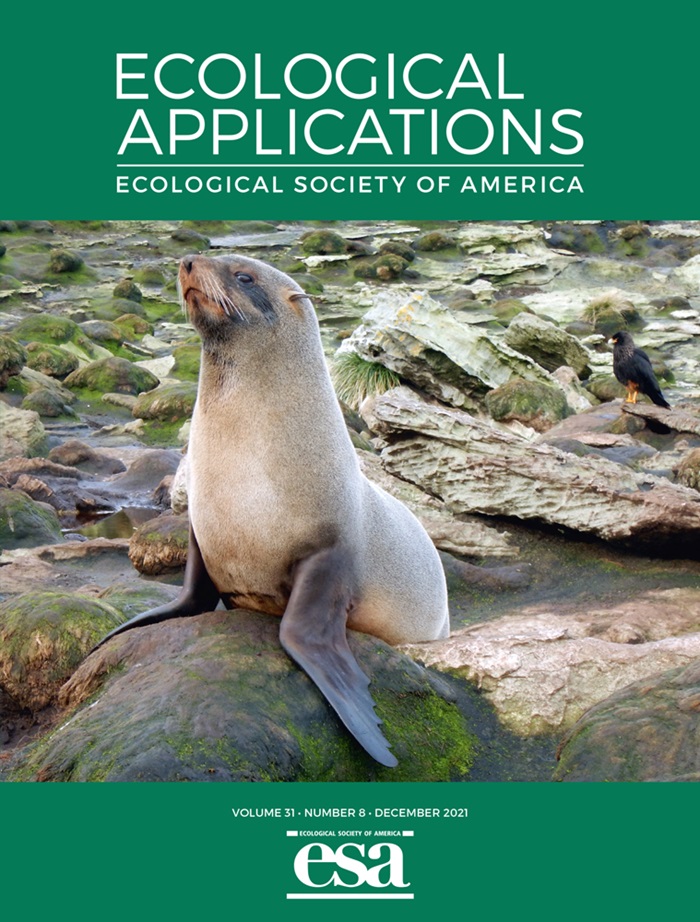Plant community composition and dominant species drive stability in aboveground production of biofuel agroecosystems
IF 4.3
2区 环境科学与生态学
Q1 ECOLOGY
引用次数: 0
Abstract
The relationship between diversity and stability remains a key question in ecology and has important consequences for understanding the sustainability (and profitability) of bioenergy cropping systems; yet to date, little work has been done to examine these relationships in agricultural systems directly. In this study, we evaluated the relationship between biodiversity (in number of planted species) and the stability of biomass production in four experimental bioenergy cropping systems established in Wisconsin and Michigan. Species composition and aboveground production were monitored at all sites for 8–10 years (2010–2019) allowing us to evaluate the temporal stability of biomass yield (defined as the temporal mean divided by the temporal SD) in these cropping systems. A major regional drought in 2012 also allowed us to evaluate resistance and resilience. Although three of the cropping systems were established with the same seed mixtures and were managed in the same way, species composition differed markedly between sites. This limited our ability to attribute differences within cropping systems across sites to the abundance of specific species. Overall, there was no clear relationship between planted species richness and yield stability in biomass production at these sites. At both sites, the lowest diversity system (switchgrass monoculture) had the highest interannual stability in production and was equivalent to that of the highest diversity treatment (prairie). Resilience to the drought was high in all treatments and did not differ among the four cropping systems; however, resistance to drought differed among systems and was highest in the switchgrass monocultures at both sites. The abundance of perennial C植物群落组成和优势种驱动生物燃料农业生态系统地上生产的稳定性
多样性和稳定性之间的关系仍然是生态学中的一个关键问题,对理解生物能源种植系统的可持续性(和盈利能力)具有重要影响;然而,迄今为止,在农业系统中直接检查这些关系的工作很少。在本研究中,我们评估了在威斯康辛州和密歇根州建立的四种实验性生物能源种植系统中生物多样性(种植物种数量)与生物量生产稳定性之间的关系。在2010-2019年的8-10年间,对所有站点的物种组成和地上产量进行了监测,从而评估了这些种植系统中生物量产量(定义为时间平均值除以时间标准差)的时间稳定性。2012年的一次重大区域性干旱也使我们能够评估抗灾能力和复原力。虽然三种种植制度是用相同的种子混合物建立的,并以相同的方式管理,但不同地点的物种组成差异显著。这限制了我们将不同地点种植系统内的差异归因于特定物种丰度的能力。总体而言,这些站点的植物物种丰富度与生物量生产的产量稳定性之间没有明显的关系。在两个样地,多样性最低的系统(柳枝稷单一栽培)具有最高的生产年际稳定性,与多样性最高的处理(草原)相当。抗旱能力各处理均较高,且4种种植制度间无差异;然而,不同系统的抗旱性不同,在两个地点的柳枝稷单一栽培中抗旱性最高。除演替样地外,在所有种植制度中,多年生C4草的丰度均随时间增加。在这两个地点的连续处理中,一年生物种的持续存在可能导致了该系统的低稳定性和高年际周转量。我们没有发现证据表明增加生物能源种植系统中种植物种的多样性可以提高地上生物量生产的稳定性;在抗旱能力和恢复力方面也没有任何差异。如果除了生物质生产之外,还希望从生物能源作物中获得其他生态系统服务,例如在景观尺度上支持多样化的传粉媒介和捕食昆虫物种,那么建立更多样化的生物能源种植系统的更高成本可能是合理的。
本文章由计算机程序翻译,如有差异,请以英文原文为准。
求助全文
约1分钟内获得全文
求助全文
来源期刊

Ecological Applications
环境科学-环境科学
CiteScore
9.50
自引率
2.00%
发文量
268
审稿时长
6 months
期刊介绍:
The pages of Ecological Applications are open to research and discussion papers that integrate ecological science and concepts with their application and implications. Of special interest are papers that develop the basic scientific principles on which environmental decision-making should rest, and those that discuss the application of ecological concepts to environmental problem solving, policy, and management. Papers that deal explicitly with policy matters are welcome. Interdisciplinary approaches are encouraged, as are short communications on emerging environmental challenges.
 求助内容:
求助内容: 应助结果提醒方式:
应助结果提醒方式:


